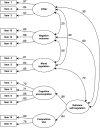The Japanese version of the Generalized Problematic Internet Use Scale 2 (GPIUS2): Psychometric evaluation and analysis of the theoretical model
- PMID: 36441746
- PMCID: PMC9704612
- DOI: 10.1371/journal.pone.0273895
The Japanese version of the Generalized Problematic Internet Use Scale 2 (GPIUS2): Psychometric evaluation and analysis of the theoretical model
Abstract
Background: The Generalized Problematic Internet Use Scale 2 (GPIUS2) is a self-administered questionnaire that evaluates problematic internet use (PIU) from a multidimensional perspective. We analysed the psychometric properties and adequacy of the theoretical model of Japanese version of the GPIUS2.
Methods: This study included 291 healthy Japanese adults (median age = 25 years; interquartile range 22-43 years; 128 women) who completed the GPIUS2 and several other questionnaires evaluating the degree of PIU, self-esteem, depression, and impulsivity.
Results: Exploratory factor analysis (EFA) revealed a similar factor structure between the original and Japanese versions of the GPIUS2, with only minor differences in item composition. Higher-order confirmatory factor analyses revealed a good overall fit for the factorial model suggested by EFA, indicating adequate construct validity. The model showed acceptable internal consistency. Partial correlation analyses between GPIUS2 and other measures, with age as a control variable, revealed good convergent validity. Finally, structural equation modelling showed a good fit to the data, supporting the cognitive-behavioural model of Caplan (2010).
Conclusions: The Japanese version of the GPIUS2 has good psychometric properties and the theoretical model of the original GPIUS2 is applicable to Japanese adults.
Copyright: © 2022 Yoshimura et al. This is an open access article distributed under the terms of the Creative Commons Attribution License, which permits unrestricted use, distribution, and reproduction in any medium, provided the original author and source are credited.
Conflict of interest statement
The authors have declared that no competing interests exist.
Figures




Similar articles
-
Psychometric evaluation of the Generalized Problematic Internet Use Scale 2 in an Italian sample.Cyberpsychol Behav Soc Netw. 2013 Oct;16(10):761-6. doi: 10.1089/cyber.2012.0429. Epub 2013 Jun 6. Cyberpsychol Behav Soc Netw. 2013. PMID: 23742149
-
The German version of the Generalized Pathological Internet Use Scale 2: a validation study.Cyberpsychol Behav Soc Netw. 2014 Jul;17(7):474-82. doi: 10.1089/cyber.2013.0706. Epub 2014 Apr 17. Cyberpsychol Behav Soc Netw. 2014. PMID: 24742070
-
The Generalized Problematic Internet Use Scale 2: Validation and test of the model to Facebook use.J Adolesc. 2017 Jan;54:51-59. doi: 10.1016/j.adolescence.2016.11.007. Epub 2016 Nov 19. J Adolesc. 2017. PMID: 27871015
-
Measurement and analysis of the cognitive-behavioral model of generalized problematic internet use among Mexican adolescents.J Adolesc. 2012 Dec;35(6):1581-91. doi: 10.1016/j.adolescence.2012.06.005. Epub 2012 Jul 11. J Adolesc. 2012. PMID: 22789467
-
The Generalized Problematic Internet Use Scale-2 in a French sample: Psychometric evaluation of the theoretical model.Encephale. 2018 Jun;44(3):192-199. doi: 10.1016/j.encep.2017.09.001. Epub 2017 Nov 20. Encephale. 2018. PMID: 29157679
Cited by
-
Alterations of the default mode network, salience network, and frontoparietal network in non-problematic Internet use and their association with mood regulation: from an internet literacy perspective.Front Neurosci. 2025 Jul 1;19:1599987. doi: 10.3389/fnins.2025.1599987. eCollection 2025. Front Neurosci. 2025. PMID: 40666258 Free PMC article.
References
-
- Cheng C, Cheung MW-L., Wang H-y. Multinational comparison of internet gaming disorder and psychosocial problems versus well-being: Meta-analysis of 20 countries. Comput Hum Behav. 2018;88:153–167. doi: 10.1016/j.chb.2018.06.033 - DOI
-
- Ostinelli E. G., Zangani C., Giordano B., Maestri D., Gambini O., D’Agostino A., et al.. Depressive symptoms and depression in individuals with internet gaming disorder: A systematic review and meta-analysis. Journal of affective disorders. 2021;284:136–142. doi: 10.1016/j.jad.2021.02.014 - DOI - PubMed

